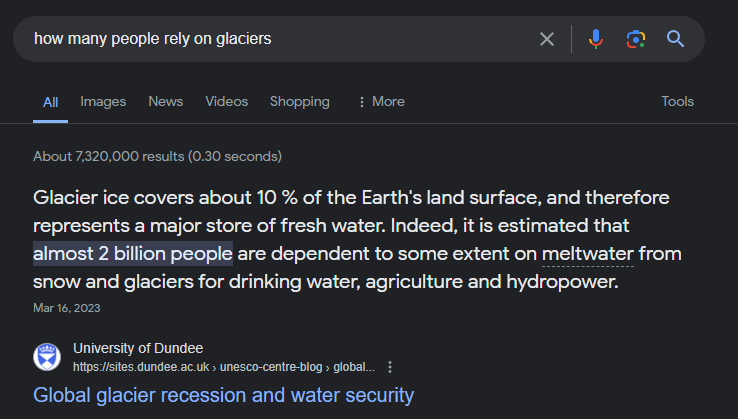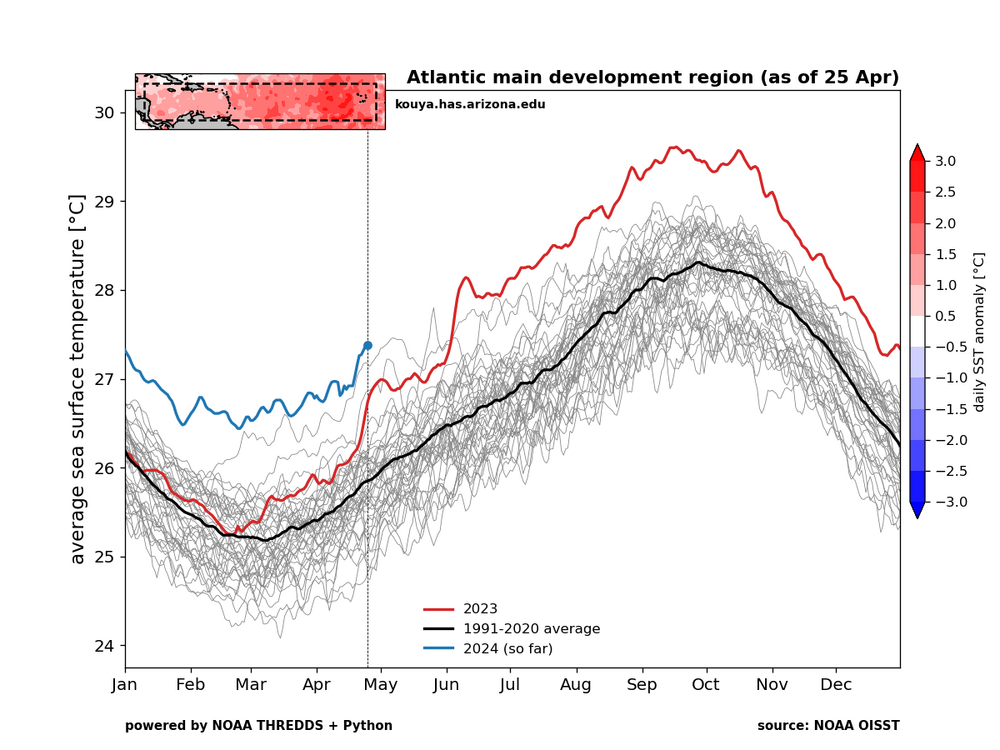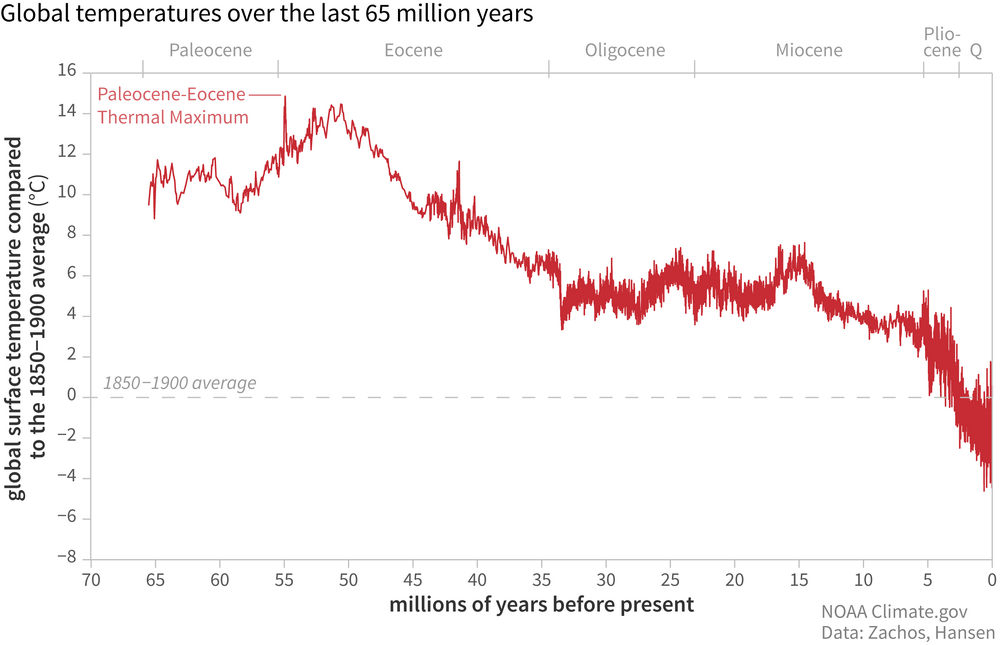
Bhs1975
-
Posts
242 -
Joined
-
Last visited
Content Type
Profiles
Blogs
Forums
American Weather
Media Demo
Store
Gallery
Posts posted by Bhs1975
-
-
Because we are all still waiting for the first actual weather event attributed to climate change that has not occurred before.... or even if you could point to more frequency of scary climate events that never occurred before. Boy that cried wolf syndrome in full force here!
All weather and climate can be contributed to climate change as we are fundamentally changing the atmosphere.-
 1
1
-
-
-
-
Where gonna have like 5 active at a time in August.
-
Numerous cities in Texas and Florida are en route to their warmest May on record. The May temperatures will likely exceed the warmest June temperatures on record in both Brownsville and Fort Lauderdale. In fact, May 2024 will be so warm in Fort Lauderdale that May 2024 will likely rank as the third warmest July there.
Looks like that's there new climate now.
.-
 2
2
-
-
Apparently it is difficult for you to detect bias in your own analysis. The station additions after 2000 have fewer 90F days than the stations that make up your network before 2000 (see Table below). That fact biases the results. Its easy to get a rough estimate of the impact of station mix change by holding 90F days constant at each stations average level for each year the station was active. If there was no station mix bias you would get a flat trend with time since each station is being held constant.
Per chart below, station mix changes after 2000 have a large impact. The changes in station mix alone would drop the number of 90F days from around 15 between the 1950s and 1990s to a little over 8 in the 2020s. As I expected, the changing station mix is driving your results not climate trends. You should repeat this analysis with the low elevation stations. Just looking at the low elevation station results for 2023, the same station mix problem appears to be present.
Of course stations are always changing as old ones drop out and new ones start up. NOAA and other experts have developed methods to account for station mix changes. If you don't employ the proper methods your results will be biased. Doubly important to follow proven methods if you aren't aware of your own bias.
He wants to create his own narrative.
.-
 1
1
-
-
i don't have the energy to debate a climate change denier in 2024 and i don't know how anyone else does
Trolling at this point. -
Yeah, subsidence caused by coastal overdevelopment and excessive groundwater pumping coupled with rising sea levels is a big concern. This is way before the expected much greater sea level rises in the future once the ice sheets begin to give way in places like Antarctica. We are only one bad hurricane or wildfire season away from one of these big state insurers of last resort going under. They had a good business report on this about a month ago. It’s probably one the biggest stories not getting much national attention. Insurance is fundamental to our whole financial system.
And when they do go under the government will have to bale them out by printing money and inflation will spiral out of control. It might even be this year with the hurricane season on steroids. -
-
One day, younger voters will be the largest share of the electorate. And if they face a materially worse climate, they may well choose abrupt breaks from existing policy arguing that failed leaders from past generations left them no other choice. Today, transitions are still possible, though the rate of needed change is much greater than it was 10-20 years ago on account of relative policy inaction. For now, the world remains on a course where it will be 2.9C warmer by 2100 (higher if Hansen is right).
Collapse would occur well before 2.9C.-
 1
1
-
-
The sun was 0.6-0.7% brighter 65 million years ago. You don't need as much CO2 for a given temperature this time around.
Antarctica glaciated around 650ppm, but my guess is that due to solar luminosity increases, you'd only need around 550-600 to deglaciate it this time around.
Humans do not appreciate just how late in the game we showed up and how lucky we are for CO2 to be as (relatively) low as it is now. Another 200-300m years and this planet is going to be a permanent hothouse.
You mean dimmer in the past. High CO2 is what kept Earth from staying frozen before life evolved to help pull the CO2 out and now that the Sun is getting hotter we have to keep it below 350ppm to keep a stable climate. That major dip in CO2 at the end is when modern humans showed up and started migrating. -
It seems like that temperature dip was necessary for human life to come around and flourish in the first place. What's true in the present day is that humanity can't support itself in an ice-free world. 2 billion people rely on glaciers for drinking water, power, and agriculture.

Yeap population will definitely drop.
. -
Humans and most plants and animals living today couldn't survive in those conditions. Only cold blooded reptiles and dinosaurs that are semi cold blooded would be able to keep from over heating. If we get to 800ppm CO2 that's where we would end up.
.-
 2
2
-
 1
1
-
-
Related to the CO2 fertilization post above, the recent study below accounted for the albedo effect of planting trees. In many places around the world, planting trees causes warming, as increases in absorbed sunlight offset the benefit from CO removal.
https://www.nature.com/articles/s41467-024-46577-1
So we would have to remove it using renewables and sequester it underground by using reactions to form limestone.
.-
 1
1
-
 1
1
-
-
Good afternoon CW. I read every one of your posts and value the civil interaction demonstrated by the different positions. I’m not qualified to speak technically but I find the example above, if I’m looking at it correctly, reflects a period of tine that was known as the dust bowl era. The effects were attributed to practices that ignored any present day sense of conservation. As a species we do seem to have the power to manipulate for the good and sadly for the bad. Please continue to post with civility as you have and I will certain read all and the responses. Never fear I do understand the ‘read more, post less axiom’ stay well, as always ….

That goes to show you that if we greatly changed our land use practices and covered as much as possible with plants it would suck down an enormous amount of CO2 and cool the climate by blocking the sunlight from heating the ground.
.-
 1
1
-
 1
1
-
-
Not many folks care about a lake freezing less but they will care when those trillions of dollars of multimillion dollar properties get swallowed up by the ocean.-
 1
1
-
-
Remember 10 years ago, when every denier was crowing about "flat temps since '98", increasing Antarctic sea ice and an impending "grand solar minimum"?
Imagine saying that, then looking at this graph and *still* wanting to short sell it.
We'll be 2C by 2030 easily.-
 1
1
-
-
The disasters will become so catastrophic and numerous that funds will run out for recovery and folks will mass migrate to less affected areas which will collapse the system. Humans will become nomadic again.
-
 2
2
-
-
That’s what’s so impressive about this is the type of damage modern well built structures took. Not many examples come to mind especially with the high rise damage. There’s no question those taller structures took 200+ mph gusts to produce what we’re seeing. Think about Laura and lake Charles. That was a cat 4 with gusts to near cat 5 measured in the city and those high rises had mostly window damage. This completely gutted entire floors and any windward facades are just gone. It’s not just one building either, it’s all of them. I don’t even think there’s a remote comparison to this storm given the city it hit
I've always wondered what Cat 5+ winds would do to a high rise building. Looks like we'll be seeing a lot more of this. -
Looks like we are going to commit climate suicide and the only solution is collapse which would set us back to before the industrial revolution.
-
 3
3
-
-
There is an EQ swarm occurring near Ojai, CA.
Could be from heavy rain
. -
Really can’t believe there isn’t more discussions around this. This is likely something we won’t see again in our lifetimes and the interior flooding has a chance, as stated, to be 1000 year event.
it’s kind of like the rareness of Ophelia a few years ago nearly making it to Ireland as tropical.
I bet we will. Climate chaos.
. -
-
Quite a few of the GFS runs have been showing a CAG like storm forming in the western Caribbean. CMC has been showing it a lot too and now EPS is hinting it at. Where it goes from there is a toss up but the fact that it forms on many models is what's important.
If it does it will be over the highest OHC in the basin.




Occasional Thoughts on Climate Change
in Climate Change
Posted
So if there is no major change then what is causing all the rapid ice loss on the planet, most of which has stable for hundreds of thousands of years?
.